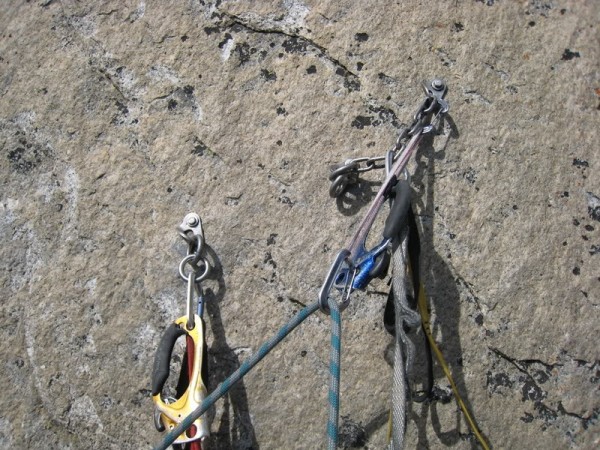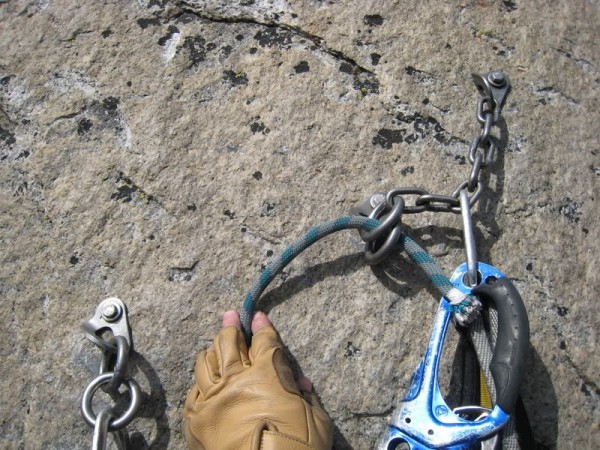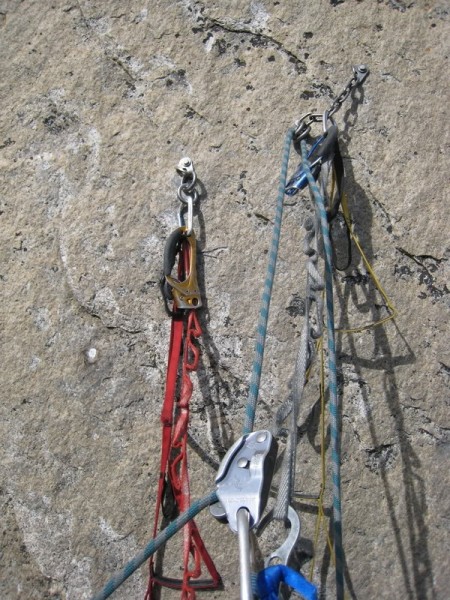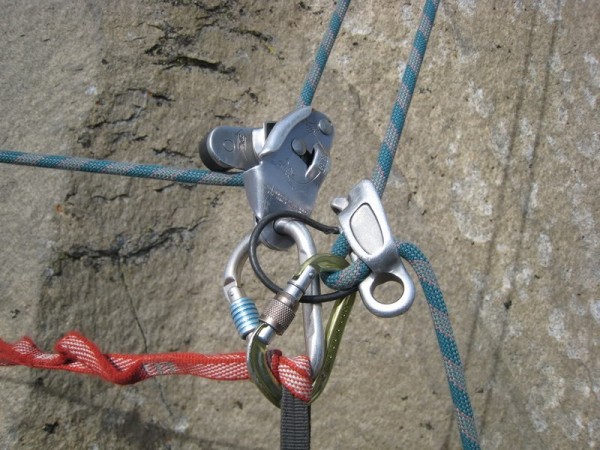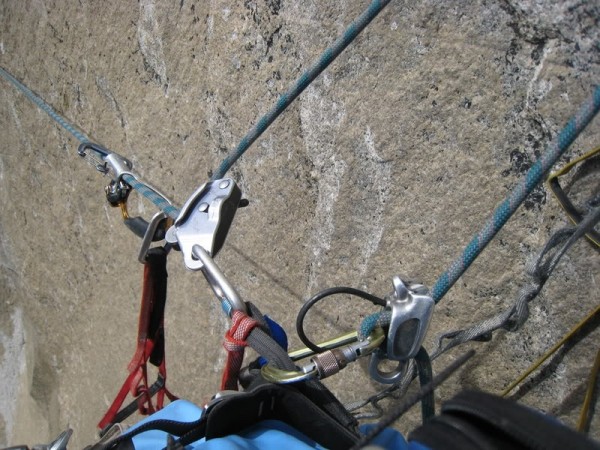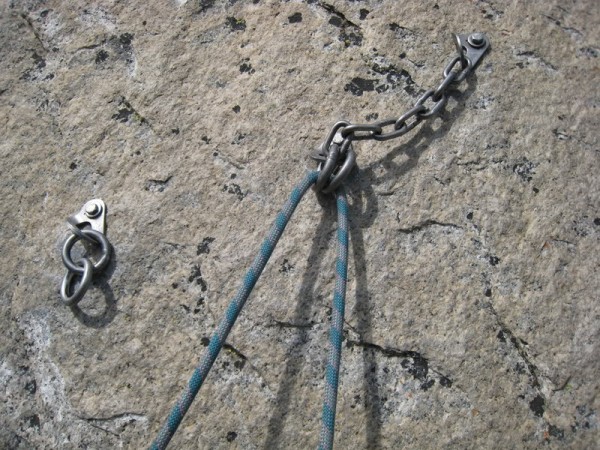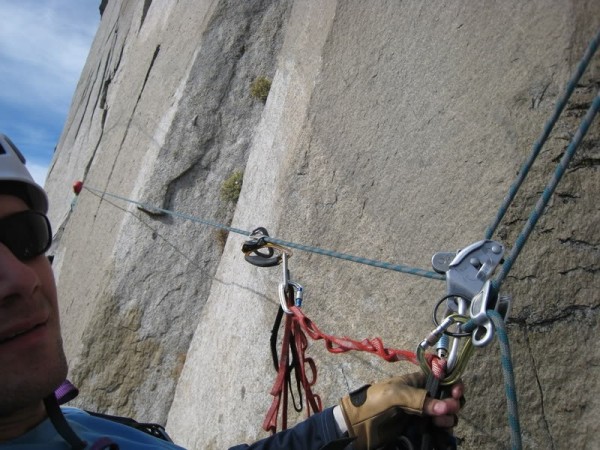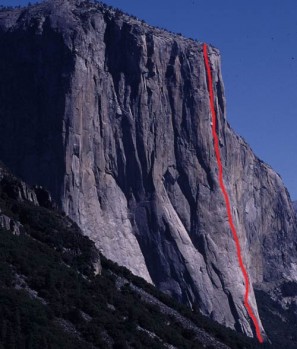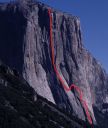Trip Report
King Swing lowerout (very simple tutorial)
|
Monday November 3, 2008 12:18pm
|
|
I'm going to shoot some video of this and get some more photos but wanted to try to explain it simply to see what people connect with and what parts need more work. So this is intended toward folks who have maybe climbed the Nose but struggled with the KS lowerout or who have some big wall experience and are looking forward to doing the Nose(so if you've never left Kansas and none of this makes any sense just bear with me--there'll be a more complete video soon:). Climbed the Nose last week so these are shots from the actual King Swing.
The goal: to do a giant lower-out, like on the King Swing, quickly and safely.
(For this sequence I'm not showing releasing the haul bag--it is pretty easy here as you just tie the bag in short and use the rest of the haul line as a long lower out line).
I'm standing on the belay ledge, belaying like normal: I"m clipped into the anchor with both my daisy chains and the lead rope is clipped through a draw on the anchor. I'm belaying with a Grigri.
After hearing "Off belay lines fixed", I untie from the end of the rope and pass it through the chains on the anchor. I'm still clipped in with both my daisy chains and the grigri is still on the rope as it was when I was belaying. All I've done is say "thank you", letting my partner know that I've heard his off belay command and am getting ready to lower out.
Now I've fed all of the rest of lead line through the lower out chains on the belay, so the fixed rope goes straight to my grigri, then up through the chains and down the Boot. The pitch is relatively short so most of the rope has been fed through the chains.
Next I put myself on rappel on the tail of the rope. So the rope goes through my grigri, up through the lower-out chains and down to my rappel device.
Now I unclip one of my daisy/jugs from the anchor and attach it to the rope. This is a very important because you can make your lower-out much shorter by pushing your jug further up the rope as you lower out.
I unclip my other daisy from the anchor(I just clip it to my harness because the two jugs tend to get in the way and make jugging sideways to shorten the lower out more difficult) and now I"m ready to lower down using my rappel device.
Clean and easy!
Advance thanks for all your feedback.
best
e
 Erik Sloan
Erik Sloan
|
 |
About the Author
Nanook is a climber from . |
Comments
 sbecker
sbecker
Sport climber
Meff-ferr, Oregon
|
 |
Nice! Thanks for the pics. But what about the pig? Seems like part of the clusterfrag of doing the KS as a wall n00b is getting the bag across.
I did The Nose about a year ago as my first wall. The only things I knew about wall climbing were what I learned between the ground and the boot (that and the 4:1 lower-out, which I learned in the gym).
What we did, which I found to be pretty easy, was retie the bag to the middle of the haul-line. Then I lowered the bag on munter while the leader hauled. Once the bag was docked, I threaded the remainder of the haul line through those chains. Then rapped the tail of the haul line with my jugs and grigri on the lead line (as pictured above). No untieing required. There was plenty of line to rap until I was directly under the anchor at which point I let the haul line run through my ATC and I was able to jug up like normal.
But maybe I just remember it being simple because I had an experienced partner yelling me through the process and telling me to hurry the f#ck up.
Anyway, thanks for the tutorial. Definitely a worthy addition to the ole bag o' tricks.
|
|
 Erik Sloan
Erik Sloan
Big Wall climber
Yosemite Big Wall
|
 |
|
Author's Reply
|
Nov 3, 2008 - 03:59pm PT
|
Excellent question. I agree that you did the easiest thing by just tying the haulbag in in the middle of the line and lowering it off the anchor. Personally I just clip it into a biner and lower it with my rappel device because too many munters makes the ropes mega twisty.
The way I describe doing the King Swing you wouldn't have to wait for the bag to be hauled and docked before doing your lower out, which would be way faster. Also you wouldn't have to keep the haul line with you, so your lower out would be cleaner as you'd just have the lead line to deal with.
Because the second half of the pitch is usually aiding for the leader, I spend that time tying the bag in short and getting it all ready to lower out on my rappel device. So I'm able to get off the belay very quickly after lowering out the bag. This way my rappel device is all ready to go on my belay loop.
|
|
 JuanDeFuca
JuanDeFuca
Big Wall climber
Peenemunde
|
 |
Why not just not tie the rope directly to your harness and not use the Grigri? Seems safer?
Juan
|
|
 Erik Sloan
Erik Sloan
Big Wall climber
Yosemite Big Wall
|
 |
|
Author's Reply
|
Nov 3, 2008 - 04:42pm PT
|
Using the grigri really speeds things up because you've been using it to belay so you don't have to take it off the rope and tie in short. It is also better than a tie in when you are lowering out as you can use a jug to pull yourself over, or shorten your lower out, and the rope will automatically feed through the grigri instead of creating a loop if you're tied in(if you do the tie-in method you would need both of your jugs on the rope which gets messy).
which is safer?
Both are probably equally safe because if you tied into the middle of your lead line you would most likely do so by clipping a knot to your harness--same as the grigri. You have a jug on the rope too so you're always into two pieces.
|
|
 hoipolloi
hoipolloi
climber
A friends backyard with the neighbors wifi
|
 |
nice walk through. made a lot of sense.
|
|
 JuanDeFuca
JuanDeFuca
Big Wall climber
Peenemunde
|
 |
I still think tying in short is safer than using a GriGri.
Am I wrong about this?
Juan
|
|
 Ottawa Doug
Ottawa Doug
Social climber
Ottawa, Canada
|
 |
Nice description Erik. I struggled up the Nose in '83. We had 3 ropes so no biggy, but I'd like to do it again sometime so the info was great.
And Sbecker, good job on learning what you needed between the start of the route and the boot flake. Sometimes that's the best way to have an adventure.
Cheers,
Doug
|
|
 Lambone
Lambone
Big Wall climber
Ashland, Or
|
 |
Scott, our way worked pretty good huh?
Erik, Scott didn't have to wait at all, as soon as my leadline was fixed and the pig was lowered out, he could rig his rappel while I was hauling cause he had all kinds of slack. He had his leadline seperate and ready for cleaning, and only had to deal with the slack of the haul rope for the rappel.
Sorry about the "Hurry the F-uck up!," but you remember our midle of the night epic to Camp IV!
RE Eriks method:
I'd probly use a backup knot below the Gri-Gri, but that's just me...
Also, rather then feeding the whole rope through the chains, I'd probly have the leader take up most of the slack and fix it short (so he can start short fixing). Then I'd feed my end through, tie to the end, then rap off the oppisite side. That way when you pull your rope you only pull about 80ft rather then 160. Less likely to get snagged below, or tangled in the wind.
|
|
 Erik Sloan
Erik Sloan
Big Wall climber
Yosemite Big Wall
|
 |
|
Author's Reply
|
Nov 4, 2008 - 07:11pm PT
|
Nice Lammy,
For sure there are always several ways that work on these endeavors. A few points about your suggestions:
While you probably don't need all of the lead line for the lowerout--We did have a rescue off the KS this year when someone pulled up too much slack and short fixed and his partner, having to cut loose, swung hard into the rock and got knocked unconscious. Those two were SAR members too, I think. So make sure you have enough rope.
The main reason why I don't agree with short fixing at that spot is the first 30 or so feet of the next pitch are easy 5.9 liebacking, which take all of a couple minutes to run up, so taking several extra minutes to set up a short fix might not be paying off in the long run there.
Good point on tying in short below the grigri--an easy way to make it supersafe (I guess I always remember DanO jumping off all those rocks onto the grigri so they seem pretty safe statically loaded and backed up((with a jug)) like that).
keep it comin!
|
|
 Lambone
Lambone
Big Wall climber
Ashland, Or
|
 |
"So make sure you have enough rope."
Good point. Critical.
With the hauline meathod it's a moot point because the haulbag should be only about 50ft below the haul anchor and the cleaner has 150ft or so of line to lower out on.
I use to not back up my gri-gri but on more then one occasion I have had my fi-fi hook get caught on the cam preventing it from opperating properly...so now I pretty mch always do now.
|
|
 sbecker
sbecker
Sport climber
Meff-ferr, Oregon
|
 |
"Scott, our way worked pretty good huh? "
I thought so! I'm keepin it in my brain for when I do it again.
"Sorry about the "Hurry the F-uck up!," but you remember our midle of the night epic to Camp IV"
That was an epic??? Could have fooled me... maybe I'm not remembering it right (don't remind me)... ;)
No worries at all about that. I can take it.
|
|
 Lambone
Lambone
Big Wall climber
Ashland, Or
|
 |
sb,
well I was epicing anyway...remember getting lost in the dark freeing some sh#t off route...
|
|
 Steve Grossman
Steve Grossman
Trad climber
Seattle, WA
|
 |
This probably doesn't concern many of you but it should. Why not simply double clip as short as possible into the lead line, hang your jugs on the down line and set up a normal rappel with the remainder to keep the sawing and wear on the Boot rings to a minimum?
|
|
 Blakeb
Blakeb
Trad climber
Ashland, Oregon
|
 |
Nice job with handling that nose for your first wall scotty. Hope to share a rope with you again soon. So eric, i guess that head cam worked out well. Talked to keving, was stoked you guys at least summited before the storm. Drop me a line, im back in the valley.
Peace blake
|
|
 Erik Sloan
Erik Sloan
Big Wall climber
Yosemite Big Wall
|
 |
|
Author's Reply
|
Nov 5, 2008 - 01:17am PT
|
Yo
Thanks for all the feedback.
Steve, good to hear your voice here, but I don't agree that the sawing action of the weight of a 150-200lb climber lowering out through steel rings is going to produce noticeable wear. Heck, you could do the same lowerout through old 1/2"webbing and it probably wouldn't break. The same set of rings has been there for my nine Nose ascents over the last five years and they don't appear worn at all.
You do bring up a good point though, as many big wall climbers lazily build anchors by clipping into the rings on a belay instead of lifting them up and clipping directly into the bolts. In my experience on El Cap that is where you see wear starting to show up on the rings, not from some lightweight lowering out.
A friend told me recently of setting up an anchor by clipping into the rings only to have their partner point out that the rings weren't even steel, but newer thicker aluminum. So please save the rings for rappelling and lowering out.
(this reply might seem a little hypocritical as I'm clearly clipped into the rings with my daisies in these photos. here I'm referring to building an anchor and power point, not merely clipping in while standing on a ledge in which case the rings work great).
while Lambone did point up another way of doing the KS lower out that works pretty well--the lower out technique shown above is a gem because you can also use it when following a long pendulum mid pitch(where up won't have the haul line to play with).
|
|
 WBraun
WBraun
climber
|
 |
This is what caught my eye immediately.
|
|
 Erik Sloan
Erik Sloan
Big Wall climber
Yosemite Big Wall
|
 |
|
Author's Reply
|
Nov 5, 2008 - 11:45am PT
|
Ha Werner, thanks, you always have a unique take on things.
Let's see:
clipped into the links?
I'm standing on a ledge, so both of my daisies(there are two) clipped into the links on the bolts are just back up.
rope clipped to top bolt?
The rope was clipped into the left bolt(to get the leader the farthest over for the swing) as well while I was belaying. So it was clipped into two bolts on anchor. The photo does look a little simplistic but when you take photos with multiple clipped in points, tie ins, ect, it starts looking very cluttered. For this tutorial I wanted to show the lower out technique cleanly. Most El Cap climbers know how to clip themselves/their rope into the anchors safely.
possible biner forced open?
Don't know if I understand your reasoning there. The quick draw is removed from the bolt and the rope is pulled tight on the grigri. During the lower out the rope is going through the chains so no possible biner snafus there. Please elaborate on this if I'm missing something.
Werner you're so old school--thanks for postin up!
|
|
 WBraun
WBraun
climber
|
 |
Eric
There's really nothing wrong here except I don't like biner gates facing towards gear. I'd rather have that one biner gate facing out away from that petzl jumar. It's just the way I visualize potential scenarios that could go wrong before they ever could happen.
I've seen so many different scenarios over the years where small subtle differences caused problems and I naturally try to avoid them before they ever have a chance to take hold.
Nice tutorial by the way, thanks.
|
|
 lunchbox
lunchbox
Big Wall climber
santa cruz, ca
|
 |
Thanks Nanook,
This is a great method to add to your El Cap play book. It comes in real handy when short fixing and lowering out at the beginning of a pitch or on long penjis.
Yeah, the 4:1 method really bit our SAR friends in the ass this summer. The aftermath certainly didn't look like fun to deal with around camp. That bear locker is huge.
|
|
 Erik Sloan
Erik Sloan
Big Wall climber
Yosemite Big Wall
|
 |
|
Author's Reply
|
Nov 5, 2008 - 12:26pm PT
|
Thanks Werner,
I appreciate your noticing and pointing out the little things like the biner facing the wrong way. You're definitely right that meticulous attention to the little details can prevent most epics/accidents. Doing the little lower out video and this tutorial has been great for me because I've got to see myself taking shortcuts/making moves that I know are less safe. It's always easier to do it right the first time. You're the man!
best
e
|
|
 Scared Silly
Scared Silly
Trad climber
|
 |
As someone who has done a few lower outs but is typically scared silly I like to be tied into something. Juan notes tying in but as you noted if you jug over as you lower out a loop forms, thus the girigri. So how much do you save by jugging over while lowering out? My guess is only a few feet and not enough to be a significant time saver in most instances. There is always the exception like when the lower over might put you over an obstacle that you would rather not deal with.
So if you do want to tie in but use the grigri how best to do this? In your tutorial, which was pretty easy to follow, you did not mention tying back in after feeding the rope through the lower out rings. Not sure if this was on purpose or an oversight. So you could tie back into the end lead rope then tie short (but hopefully not too short).
|
|
 Erik Sloan
Erik Sloan
Big Wall climber
Yosemite Big Wall
|
 |
|
Author's Reply
|
Nov 5, 2008 - 01:14pm PT
|
Excellent questions SS,
You're right that I left off at the end of the tutorial. I will add a line that after completing the lower out you pull the lead line through the chains and retie into the end. Thanks.
There would be no reduction of grigri benefits if you tied in short after pulling the grigri tight. And if you keep the grigri on the rope you will still be able to jug sideways and reduce your lower out. I think the sideways jugging, while intellectually trivial, adds up significantly in real time.
So I would encourage you to tie in below the grigri if that added level of safety is important to you. Excellent suggestion.
A word about this: folks like Chris Mac and I have done so much big wall climbing that we have lots of personal experience with concepts like the grigri and the jugs almost never coming off the rope or failing. So we usually(on normally lower outs) don't put a biner on top of the jug, or tie in short below the grigri as I've shown here. But I always teach beginners to do these things at first because it is important to learn from your actual experience, rather than just take someone's word for how safe something is. Believe it or not the way a jug is loaded has a lot to do with it's ability to slip or come off the rope, so having tons of experience jugging sideways does actually equate to being more skilled at lowering out; keeping the grigri weighted and in the locked-up position also helps prevent it from possibly moving limply around your harness where the cam might get hooked by your fifi, as Lambone pointed out, and "fail." So if it looks sometimes like pro big wall climbers take more risks know that there is also a balance of skill that helps to mitigate those risks. Always do what feels appropriately safe for you.
|
|
 climbingbuzz
climbingbuzz
Trad climber
SF, CA
|
 |
|
|
Nov 10, 2008 - 11:03pm PT
|
Can eliminate the jug and the gri gri. Follower clips a draw from his harness to the rope fixed to eagle and rappels almost straight to eagle, not straight down like in the photo. Follower stays tied in if the leader does the threading through the rings.
|
|
 golsen
golsen
Social climber
kennewick, wa
|
 |
|
|
Nov 10, 2008 - 11:15pm PT
|
kewl tip.
however, my first el cap venture was NIAD, 2nd was Salathe IAD. Partner, well, 1st and 2nd big wall.
And I lived in Kansas, I learned to take it personally with all the KS jokes but that was 15 years ago.
For me, this stuff look all so complicated versus simpley knowing how to climb at the requisite level.
Point is, these tricks are no substitute for knowing how to climb.
That aint saying this isnt a good thing to do, but for tose of you with goals of NIAD, learn how to climb first, this sh#t aint going to help you unless you know how to climb first.
For me, I like to KISS.
|
|
 enjoimx
enjoimx
Trad climber
Yosemite
|
 |
|
|
Nov 11, 2008 - 12:51am PT
|
Seems complicated
Easiest way: Leader fixes ropes on eagle ledge and you just rap to him with a quickdraw keeping you tight to the fixed line, pull the ropes and your done.
|
|
 Ihateplastic
Ihateplastic
Trad climber
It ain't El Cap, Oregon
|
 |
|
|
Nov 11, 2008 - 01:06pm PT
|
Tiny point, I suppose, but I have always been under the belief that all 'biners should be flipped so the gate is out. REGARDLESS of whether it is "safe." So, while the 'biner issue Werner pointed out may not be an issue, what about the 'biner on the gold jug? Again, probably not a real safety issue, but have we moved away from flipping 'biners as a matter of habit?
Sorry... to many uses of the word "issue."
|
|
 Rhodo-Router
Rhodo-Router
Gym climber
sawatch choss
|
 |
|
|
Nov 11, 2008 - 02:44pm PT
|
Thinking way ahead there with that leader doing the threading. Might be a bit rope-draggy though.
|
|
 Erik Sloan
Erik Sloan
Big Wall climber
Yosemite Big Wall
|
 |
|
Author's Reply
|
Nov 11, 2008 - 03:57pm PT
|
Interesting posts. Thanks.
I feel it necessary to point out that these last several posts seem to suggest that stopping on Eagle ledge after doing the King Swing is routinely done or appropriate for most parties. For most of us it is faster and more convenient to lead a 5.10 or C1 pitch on toprop, instead of rappelling down and doing an extra pitch. Also, since most parties are hauling on the Nose stopping on Eagle ledge would mean lowering your haulbags down a long way, which goes against the grain of the ascent.
Don't know if I agree that these "tricks" are ever used as a substitute for climbing solidly. To me, most parties that make it to pitch 16 on the Nose now how to lead climb pretty well. What I see over and over on El Cap is competent parties spending
as long at the belay, or cleaning a pitch, as they do leading a pitch. That's the gravity accelerator, for sure.
weather's good, the granite waves are sparklin.....
AAAAiiiiiiiiiigh, the Captain calls!
|
|
 Mike Schneiter
Mike Schneiter
Big Wall climber
Glenwood Springs, CO
|
 |
I wonder if many NIAD parties do as some of the recent posts suggest - having the leader stop at Eagle's Ledge and the follower rapping from the top of Boot to Eagle's Ledge.
On our NIAD this summer that's what we did because it was a good place to swap blocks, plus it was super quick to do it as thus: leader ran it out on the Boot, anchored themselves, short fixed to a grigri so they could lower the second and then the second went immediately into the King Swing. As soon as the second hit Eagle Ledge they anchored, and tied off their end to the anchor, from which the Boot Flake leader could rap off of with a grigri, the rope secured to the top of the Boot with a couple of biners and the leader being pulled in to Eagle's Ledge by a simple quickdraw on the harness and connected to the rope running from Eagle's to the Boot.
I like the photos though. Makes good sense to do it that way when climbing wall style.
|
|
 Studly
Studly
Trad climber
WA
|
 |
|
|
Jun 15, 2009 - 12:01pm PT
|
Time to get on it!
|
|
|
 |
 |
The Nose—the best rock climb in the world! Photo: Mark Kroese
Recent Trip Reports
- The Kohala Ditch Trail: 36ish hrs on foot... to and from the headwaters. [5 of 5]
May 31, 2019; 11:57pm
- A Winter Traverse of the California section of the PCT Part 8
May 31, 2019; 11:18pm
- Supertopo,A trip report for posterity
May 31, 2019; 11:00pm
- Balch Fest 2013. Two Days in and Around and On The Flake. The Official Trip Report
May 31, 2019; 10:57pm
- TR: My visit to the Canoe
May 31, 2019; 10:24pm
- Death, Alpine Climbing, The Shield on El Cap
May 31, 2019; 4:07pm
- Andy Nisbet (1953-2019)
May 31, 2019; 2:11pm
- Drama on Baboquivari Peak
May 31, 2019; 1:19pm
- Joffre + The Aemmer Couloir: ski descents come unexpected catharsis [part 2]
May 31, 2019; 7:45am
- Lost To The Sea, by Disaster Master
May 30, 2019; 5:36am
- My Up And Down Life, Disaster Master
May 29, 2019; 11:44pm
- Halibut Hats and Climbers-What Gives?
May 29, 2019; 7:24pm
- G Rubberfat Overhang-First Ascent 1961
May 29, 2019; 12:28pm
- Coonyard Pinnacle 50 Years Later
May 29, 2019; 12:24pm
- Great Pumpkin with Mr Kamps and McClinsky- 1971
May 29, 2019; 12:02pm
- View more trip reports >
Other Routes on El Capitan
|
| Freerider, 5.12D
El Capitan
The Salathé Wall ascends the most natural line up El Cap. |
|
| Zodiac, A2 5.7
El Capitan
1800' of fantastic climbing. |
|
| Salathe Wall, 5.13b or 5.9 C2
El Capitan
The Salathé Wall ascends the most natural line up El Cap. |
|
| Lurking Fear, C2F 5.7
El Capitan
Lurking Fear is route number 1. |
|
| East Buttress, 5.10b
El Capitan
East Buttress with top of The Nose on left. |
|
